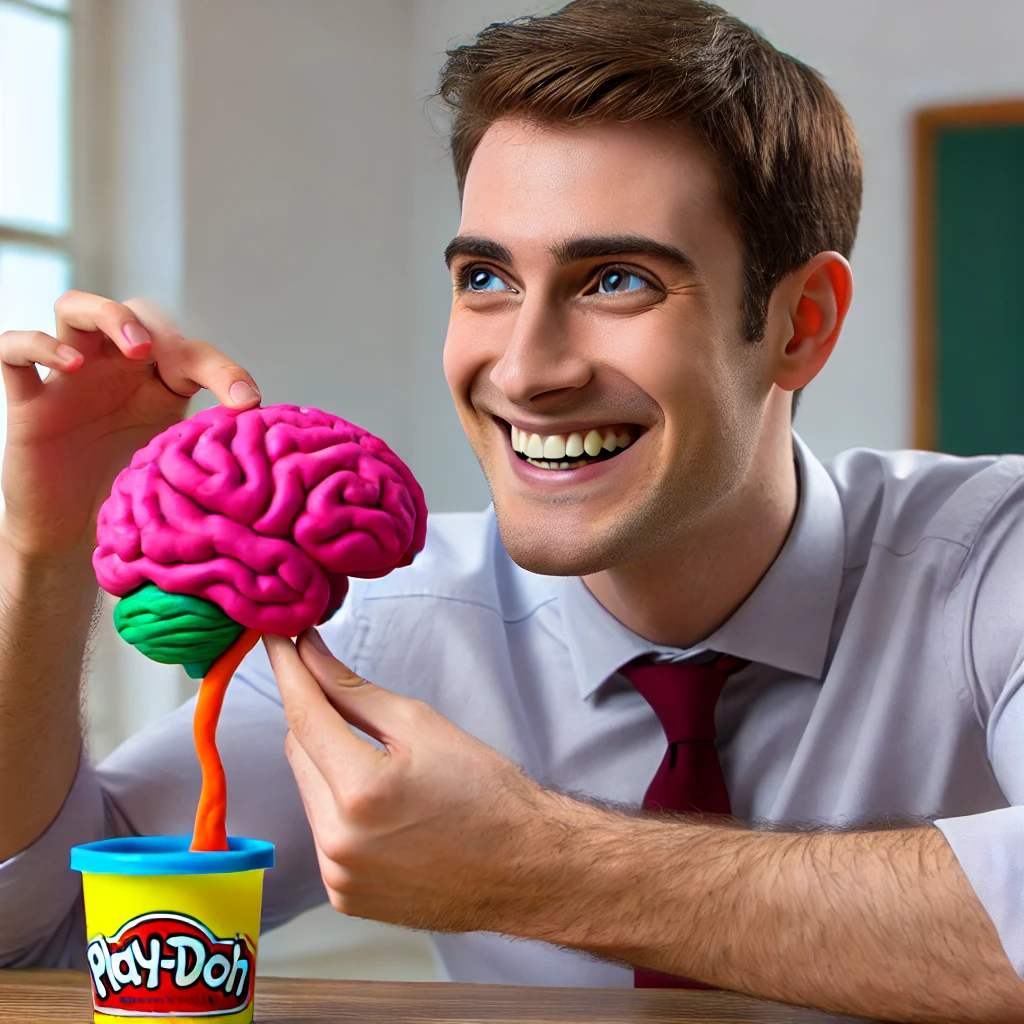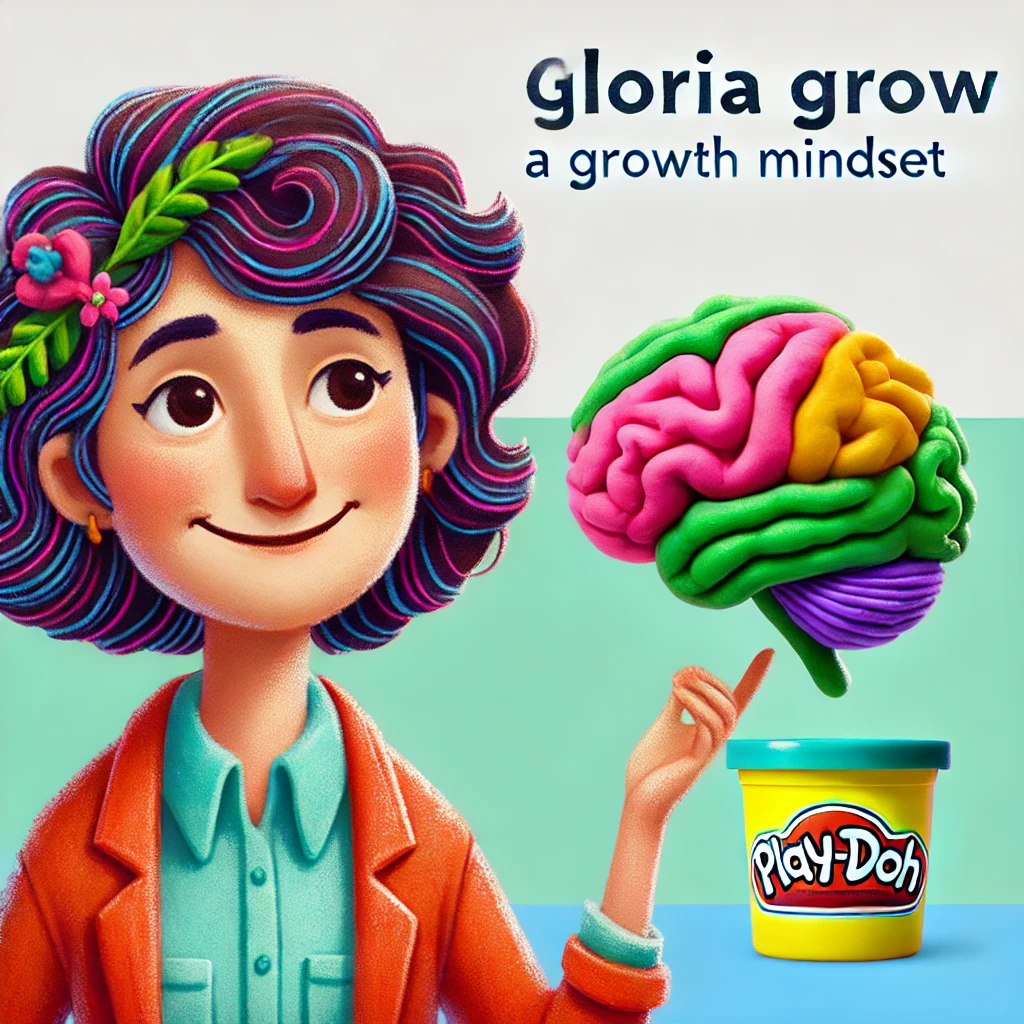Is Your Brain Stuck in Cement? Unpacking the Fixed Mindset
Picture this: your brain, nestled comfortably in the confines of your skull, has suddenly morphed into a cement block. It’s solid and unyielding like that sidewalk you tripped on last week (don’t worry; we all saw it). This is what being stuck in a fixed mindset feels like. On the other hand, imagine if instead of concrete grey matter, you had something more akin to Play-Doh up there – malleable and ready for any shape or form – welcome to growth mindset territory!
First off ,though, let’s not be too hard on our cement-brained compatriots because having such an immovable noggin does have its perks! A fixed mindset provides comfort with consistency. You know where things stand because they’re always standing right there… exactly where they were yesterday… and three years ago… maybe even back when dinosaurs roamed Earth.

In contrast, those sporting Play-Doh brains are constantly reshaping their thoughts based on new experiences or information. They revel in change as much as cats love laser pointers–with equal parts enthusiasm and curiosity.
But here comes the punchline folks! The drawback of living life with a cement mixer between your ears is stagnation – just ask my pet rock collection from third grade which hasn’t seen much action since 1994 (I swear I’ll dust them one day!). With everything set firmly ‘as-is’, learning becomes harder than trying to teach grandma how to use emojis appropriately (“No Grandma 👹 doesn’t mean ‘cute little devil'”).
On the flip side, however, lies our squishy-minded friends who view challenges less like impenetrable brick walls but rather opportunities for expansion—think marshmallows meeting microwaves—BAM!, instant fluffy goodness everywhere!
So now you might be sitting there thinking “well shoot—I don’t want my cerebrum resembling construction material”, but fear not, dear reader–you’re already halfway to Play-Doh paradise simply by acknowledging the existence of these two mindsets. The first step towards a growth mindset is recognizing that, like your favorite pair of jeans after the holiday season, our brains can stretch and adapt.
And remember folks: while cement might be great for building skyscrapers or crafting stylish garden gnomes (you know you want one), it’s less than ideal when it comes to personal development. So, let’s trade in those hard hats for thinking caps and get ready to mold some mental masterpieces! Because who wants a brain stuck in cement when we could have minds as flexible as Olympic gymnasts performing gravity-defying feats?
So, whether you’re currently more concrete-craniumed or doughy domed – just remember this: change isn’t something to fear but rather an opportunity decked out with neon lights screaming “Come on down! You’re the next contestant on ‘The Price Is Growth!'”. And hey- even if right now your brain feels denser than Aunt Patty’s fruitcake at Christmas time – don’t fret; every journey starts somewhere, so why not here?

Sherlock Holmes vs Homer Simpson: A Tale of Two Mindsets in Pop Culture
Sherlock Holmes and Homer Simpson: two names that couldn’t be more different, yet they’re both pop culture icons in their own right. On one hand, we have the cerebral detective par excellence who uses critical thinking to solve even the most complex of crimes. On the other side, is our lovable oaf from Springfield whose decision-making skills often leave much to be desired.
Let’s start with Sherlock. He embodies a growth mindset – an intellectual powerhouse who never shies away from challenges, but instead embraces them as opportunities for learning and personal development. His mind works like clockwork precision machinery – always ticking, examining every detail no matter how minuscule it may seem at first glance. There’s nothing too trivial or insignificant for his eagle eye! Watson might occasionally roll his eyes at Sherlock’s obsession with details, but let’s face it – without this relentless pursuit of knowledge and understanding, Moriarty would probably rule London by now!
Now imagine if you will (and I know this is hard), Sherlock sitting down after a long day of crime-solving…to watch The Simpsons? You’d think he’d find little value in Homer Simpson’s antics given their starkly contrasting personalities–but perhaps there are lessons to learn here, too.
Homer epitomizes what Carol Dweck calls a “fixed” mindset—a belief that abilities are innate gifts rather than something developed over time through effortful study or practice—essentially saying, “You either got it or you don’t.” He loves beer more than brain teasers and doughnuts over deduction mysteries any day! Yet despite these seemingly insurmountable shortcomings compared to someone like Holmes—he still manages not only survive—but thrive (in some strange way) within his world.
This comparison between our favorite consulting detective and cartoon dad isn’t meant as an insult towards anyone possessing characteristics similar to those exhibited by Mr.Simpson—it merely serves to illustrate how differing perspectives can lead us down varied paths in life. The key takeaway here is that while Sherlock’s growth mindset allows him to continually evolve and adapt, Homer’s fixed perspective often lands him in hot water (or a vat of beer).
But let’s not forget – amid all the face-palming moments he provides us with, there are times when even Homer surprises everyone by demonstrating unexpected insights or solving problems in ways no one else could have imagined. Could it be an unconscious spark of genius? An untapped potential masked beneath layers of laziness and donuts? Or just pure dumb luck?
In essence, both characters offer valuable lessons for our personal development journey: While Sherlock Holmes teaches us about the power inherent within a growth mindset—embracing challenges as opportunities for learning; perseverance against difficulties; resilience amidst failures–Homer Simpson reminds us that sometimes we can get too caught up in trying to reach perfection—that it’s okay to embrace who you truly are—even if this means accepting your flaws along with strengths.
So next time you find yourself faced with a challenge—whether at work or home – ask yourself: What would Sherlock do? But also remember—it doesn’t hurt occasionally think like Homer either! After all—we’re only human—and every now then—a doughnut might actually provide the answer needed to solve the problem at hand!
Sherlock Holmes vs. Homer Simpson—an unlikely duo indeed—but together they form the perfect case study on contrasting mindsets in pop culture—one steeped in continual self-improvement, and the other contentment with the status quo, despite its pitfalls…and occasional hilarity ensuing from such complacency! So, whether you’re more Sherlocked than Simpsified—or vice versa—I hope their tales bring to light the importance of understanding different perspectives towards personal growth.
Growth Mindset: The Secret Sauce for Becoming a Jeopardy Champion?
Just imagine, for a moment, that you’re sitting on the Jeopardy! set. Bright lights are shining in your face and Alex Trebek is throwing questions at you faster than an over-caffeinated squirrel can hoard acorns. Your brain feels like it’s running a marathon while simultaneously trying to solve quantum physics equations.

On one side of this mental battlefield stands the fixed mindset – let’s call him Mr. Fixed – dressed up as if he walked straight out of Mad Men; slicked-back hair, pinstripe suit and all! He believes intelligence is static; what God gave you at birth is all there will ever be.
Across from him we have Ms. Growth Mindset (Ms. GM), looking every bit as radiant as Lady Gaga during her Super Bowl halftime show performance but with fewer costume changes! She firmly believes abilities can be developed through dedication and hard work—brains and talent are just starting points!
Now picture them both vying for Jeopardy champion status:
Mr. Fixed buzzes in first: “What’s the capital of France?” Without missing a beat or loosening his tie knot even slightly, he answers confidently, “Paris”. A smirk appears on his face because well… duh…it was easy!
But then comes something more challenging like “Who won the Nobel Prize in Physics in 1933?”. His hand freezes above the buzzer…his confident smile fades quicker than cheap cologne after three hours under hot studio lights…
Meanwhile our friend Ms.GM isn’t flustered by these curveballs thrown by Trebek himself! Sure, she may not know who won that specific Nobel prize offhand, but she doesn’t panic either.
Her philosophy has always been about learning continuously rather than knowing everything right away. So instead of freezing up when faced with unknowns such as this question, she takes it head-on without fear or hesitation, because hey, it’s another opportunity to learn!
And that, dear readers, is the secret sauce to becoming a Jeopardy champion. It’s not about knowing all the answers right off the bat – it’s about having an open mind and being ready to learn.
The fixed mindset might get you through some early rounds with easy questions but when things start getting tricky (and they always do!), that rigid belief system will leave you floundering like a fish out of water!
On other hand, the growth mindset equips you for long-term success by fostering resilience in face of adversity or failure, because at end day, it’s not just what we know, but how willing we are to keep learning more.
So which contestant would you rather be? The stiff Mr. Fixed who crumbles under pressure or Ms. GM who faces challenges head-on with courage and curiosity? Remember folks– on Jeopardy! as in life, your attitude makes all difference! And now let’s take commercial break– don’t touch that dial…we’ll back after these messages from our sponsors…

The Good, The Bad, and The Ugly Decision-Making: A Comedy of Errors or Growth Opportunities?
The world of decision-making is a lot like an old spaghetti western film. It’s got the good, the bad, and sometimes it gets downright ugly. Picture this: You’re Clint Eastwood in A Fistful of Dollars, squinting into the horizon as you contemplate your next move – should you take on that new project at work or stick to what you know? Should I study for another degree or focus on my current job?
Let’s start with ‘the Good’. The “good” decisions are those golden moments when everything falls into place just right. You feel like Sherlock Holmes cracking a particularly challenging case – minus Benedict Cumberbatch’s cheekbones (unfortunately). These choices make us feel invincible; we strut around our own little stage as if we’ve cracked life’s secret code.
Then comes ‘the Bad’. They’re not so much fun, but hey! They add some spice to our lives – imagine living without any spicy food…boring, isn’t it? So yeah! We embrace them, too, because they provide valuable lessons wrapped up in slightly distasteful packages (like receiving socks for Christmas). And let me tell ya’, there’s nothing quite humbling than realizing halfway through cooking, that substituting salt with sugar wasn’t such a great idea after all!
Finally, ‘the Ugly’ part of decision-making rears its head when things go South faster than migrating geese during winter time. This is where comedy ensues – think slipping-on-a-banana-peel kind of funny situations which leave everyone laughing, except perhaps yourself– who might be nursing a bruised ego and maybe even literal bruises.
Now herein lies the twist: these three categories can also represent two contrasting mindsets—growth vs fixed mindset, respectively—and how they deal differently under similar circumstances.
In one corner wearing red gloves representing Fixed Mindset Boxing Club is someone who sees failure as catastrophic—an end point rather than starting line—a comedy of errors, if you will. They’re the ones who’d probably look at a failed decision and think “Well, I’m never doing THAT again.” This mindset is like trying to navigate through life with a map that only shows one route; any deviation from this path is seen as failure.
In the other corner wearing blue gloves representing Growth Mindset Boxing Club are those who view their failures simply as stepping stones towards success—a growth opportunity in disguise. These folks dust themselves off after slipping on that proverbial banana peel and laugh along because they know it’s just part of learning process—more like an improv theater than scripted drama!
So let’s take our previous cooking disaster for example: Fixed mindset would see it as proof they can’t cook, while Growth mindset might chuckle saying “I guess next time we’ll stick to the actual recipe!” or even better – write down “Sugar ≠ Salt” somewhere visible in the kitchen!
The beauty lies not so much in avoiding bad decisions (because trust me, no matter how hard you try there WILL be some), but rather changing your perspective about them – transforming “ugly” into opportunities; turning comedies of error into laughter-filled lessons learned.
Remember every spaghetti western film has its share of good guys winning over villains despite all odds stacked against them? That’s exactly what happens when we embrace growth instead of fearing failure. The plot twists aren’t setbacks—they’re setups—for us to come out stronger than before!
And thus ends our tale set amidst dusty trails where tumbleweeds roll across the screen carrying messages about resilience & personal growth hidden within hilarious misadventures called ‘decision making’. So, saddle up partner! It’s high noon and world awaits your choices — whether Good, Bad, or Ugly, remember each one carries the potential for unimaginable growth—if viewed through right lens.
Learning with Laughter: How a Growth Mindset Makes You the Class Clown of Knowledge Acquisition
Picture this: you’re in a comedy club, the spotlight is on two performers. On one side, we have Mr. Fixed Mindset – let’s call him ‘Freddy Fixation.’ Freddy’s act is predictable and consistent; he tells the same jokes every night with no variation or room for improvisation because that’s his comfort zone.
On the other hand, meet Ms. Growth Mindset – fondly known as ‘Gloria Grow.’ Gloria isn’t afraid of risks; she experiments with her routine each night – sometimes it lands perfectly and gets uproarious laughter from the crowd, while at times she falls flat but learns something new about what makes people laugh.

Let’s compare these two comedians to our learning habits shall we?
Freddy Fixation represents those who hold onto a fixed mindset towards knowledge acquisition like they’re clinging onto their last slice of pizza during an apocalypse! They believe intelligence is static—a set quantity doled out at birth that can never be increased nor decreased—just like Freddy believes there are only so many laughs to go around per joke told (and boy does he count them!). These individuals approach learning defensively—they avoid challenges fearing failure will expose their limitations rather than seeing them as opportunities to grow smarter through hard work and persistence.
Now let’s turn our attention to Gloria Grow whose growth mindset echoes her comedic style — experimental, risk-taking yet resilient! She sees intelligence not as finite but malleable just like play-doh (remember how much fun it was squishing that stuff?). Those adopting this perspective see potential everywhere—even when bombing on stage—because they know effort breeds success more reliably than innate talent alone ever could!
The beauty of contrast between these mindsets lies not in labeling one good or bad—it would be too simple then wouldn’t it?—but understanding how each influences us differently throughout life’s journey into personal development land where unicorns roam free… okay, maybe I got carried away there!
But seriously, think about it. Freddy Fixation’s fixed mindset may keep him from bombing on stage but also limits his growth as a comedian—he might never know the thrill of creating an original joke that sends waves of laughter through the audience! Meanwhile, Gloria Grow’s willingness to experiment and learn from her mistakes allows for continuous personal development—she becomes funnier with each performance, because she learns what works and doesn’t.
So who do you want to be? The class clown stuck repeating old jokes, or one evolving their humor repertoire based on experience?
Remember this: A growth mindset isn’t just about becoming smarter—it’s really more like being the class clown in knowledge acquisition; not fearing failure but embracing it as part of learning process. It means seeing challenges not as scary monsters under your bed (or hecklers in the crowd) but opportunities for improvement—a chance to tell better jokes next time around!
In conclusion, whether you’re Freddy Fixation or Gloria Grow is up to you—and no matter where you stand today, remember change possible if you are willing to put effort into changing your perspective towards learning… But hey, don’t take my word for it—try telling a few bad jokes to see how much you can learn!
Famous Fails to Fabulous Feats – Celebrities’ Journey from Fixed to Growth Mindset
Ah, the world of celebrities! A glitzy facade that often masks a gritty reality. Let’s dive into this glamorous universe and pull back the curtain on two beloved stars who’ve made spectacular journeys from fixed to growth mindsets: Jim Carrey and J.K. Rowling.
Jim Carrey, our rubber-faced funnyman known for his slapstick humor in movies like Ace Ventura or intense performances in The Truman Show, wasn’t always laughing it up. Raised in poverty-stricken circumstances where he even had to work as a janitor at 15 years old just to support his family – talk about not having time for clowning around!
Carrey initially harbored a very fixed mindset; he believed talent was innate and success came only through luck or divine intervention (like being struck by comedic lightning). He thought there were limits set upon him due to his background that could never be overcome – until one day when everything changed.
In contrast with her magical creations, J.K. Rowling’s life before Harry Potter fame resembled less Hogwarts School of Witchcraft & Wizardry but more Dursley’s gloomy household under-the-stairs accommodation! She suffered multiple setbacks including divorce, single parenthood while living on unemployment benefits which led her towards depression.
Rowling also started off with a fixed mindset believing she was destined for failure, because all odds seemed stacked against her–she felt trapped within invisible boundaries drawn by societal expectations along with personal hardships. But then…Abracadabra!
Now let’s see how these famous fails turned into fabulous feats:
Firstly comes Mr. Caricature himself-Jim Carrey. He swapped out self-limiting beliefs faster than movie roles once he realized hard work coupled with perseverance are key ingredients leading towards a success recipe. His new mantra became “I can” instead of “I can’t”. This shift allowed him to go after dreams fearlessly, eventually landing him the iconic roles we cherish today. Remember folks, this guy used to visualize a successful career while sitting on te Hollywood hills before even getting his first gig!
On the other hand, we’ve got J.K.Rowling who swapped her invisibility cloak for a pen and paper. She decided to use hardship as fuel rather than an excuse to give up. Rowling started believing in herself despite repeated rejections from publishers (12 times if you’re counting!). Her growth mindset eventually led her to creating one of most beloved series world has ever known–Harry Potter.
So here’s take away folks: Just like Carrey and Rowling, you too, can transform your life by shifting towards a growth mindset. No matter how many boggarts pop out dark corners or Grinches try steal your joy, don’t let them define your limits! Remember, it’s not about where you start, but finishes that count. And hey, if these two could succeed under such challenging circumstances, then so can you!
In conclusion, whether pulling faces for laughs or crafting magical worlds from imagination – both our celebrities proved beyond a doubt that having the right attitude makes all the difference between moping around with a fixed mindset versus soaring high with the power of growth mentality. So next time find yourself stuck, remember this comparison and say, “Lumos Maxima” shedding light upon the path leading towards personal development success. Happy growing!
Bridging the Gap Between ‘Can’t Do’ and ‘Not Yet’: Funny Dialogues That Teach Us About Personal Growth
In the vast universe of personal growth, two characters often take center stage – Mr. ‘Can’t Do’ and Ms. ‘Not Yet’. These are not your typical superheroes from a Marvel movie or sitcom stars with laugh tracks; rather they represent our internal dialogues that shape our mindset – fixed vs growth.
Mr. ‘Can’t Do’ is quite an interesting character, always armed with reasons why something can’t be done, as if he has graduated summa cum laude from the University of Naysayers! He’s like Sheldon Cooper in The Big Bang Theory, who would calculate all possible outcomes before taking any action, and then choose to do nothing because there’s a 0.0001% chance things might go wrong!
On one occasion when faced with learning Python for his job role expansion (he works at a tech firm), Mr.’ Can’t Do’, instead of embracing this opportunity said: “I’m no good at coding; I’ll never get it right”. His tone was so convincing that you’d think he had seen into future using some sort of crystal ball technology only available in Star Trek episodes!
Contrastingly enters Ms.’ Not Yet’. She represents every person who believes their abilities can grow over time through effort and persistence- embodying Dory from Finding Nemo, chanting her mantra “Just keep swimming.” When confronted by challenges such as public speaking or mastering Excel formulas, which may seem daunting initially, she says: “I haven’t got it…not yet.”
She doesn’t deny failure, but sees it merely as a temporary setback on the road to success, just like Michael Scott did in The Office, despite numerous blunders while managing the Dunder Mifflin Scranton branch! Her belief system echoes Yoda’s wisdom in Star Wars -“Do or do not…there is no try.”
Let us illustrate further by imagining these mindsets embodied within two aspiring comedians navigating stand-up comedy world– a daunting task that requires resilience and personal growth. Mr.’ Can’t Do’ would be like George Costanza from Seinfeld, convinced he’s doomed to fail after one bad gig: “I bombed tonight, I’m just not funny!” He’d probably quit the comedy circuit faster than you can say “yada yada yada!”
Ms.’ Not Yet’, on other hand, channels her inner Phoebe Buffay of Friends fame. Even when she writes a song about smelly cats that gets ridiculed by some (and adored by others), she doesn’t give up; instead says with unwavering optimism -“They don’t get it…not yet.” She keeps refining her material until Central Perk customers are rolling in the aisles.
Both these characters teach us valuable lessons about mindset. While Mr.’ Can’t Do’ is quick to write off his abilities as fixed traits leading him towards stagnation and frustration- akin to Ross Geller stuck in second gear for ten seasons! Ms.’Not Yet’ embraces challenges seeing them as opportunities for improvement resulting in continuous learning curve similar to Ted Mosby’s relentless search for love throughout How I Met Your Mother series!
In essence, bridging the gap between ‘Can’t do’ and ‘Not yet’ involves shifting our internal dialogues from self-defeatist statements rooted deeply within Sheldon Cooper or George Costanza-like pessimism towards more optimistic affirmations resonating Yoda’s wisdom or Phoebe Buffay’s unyielding spirit.
So next time challenge rears its head remember: You might not have conquered it…YET, but keep swimming because every setback is setup for comeback, even if your life seems more sitcom blooper reel than highlight reel at times!
Copyright Disclaimer
Pursuant to Section 107 of the Copyright Act of 1976, fair use is permitted for activities such as criticism, commentary, news reporting, teaching, scholarship, and research. Fair use is authorized by copyright law and allows for uses that might otherwise constitute infringement. Non-profit, educational, or personal use further supports the balance in favor of fair use.



